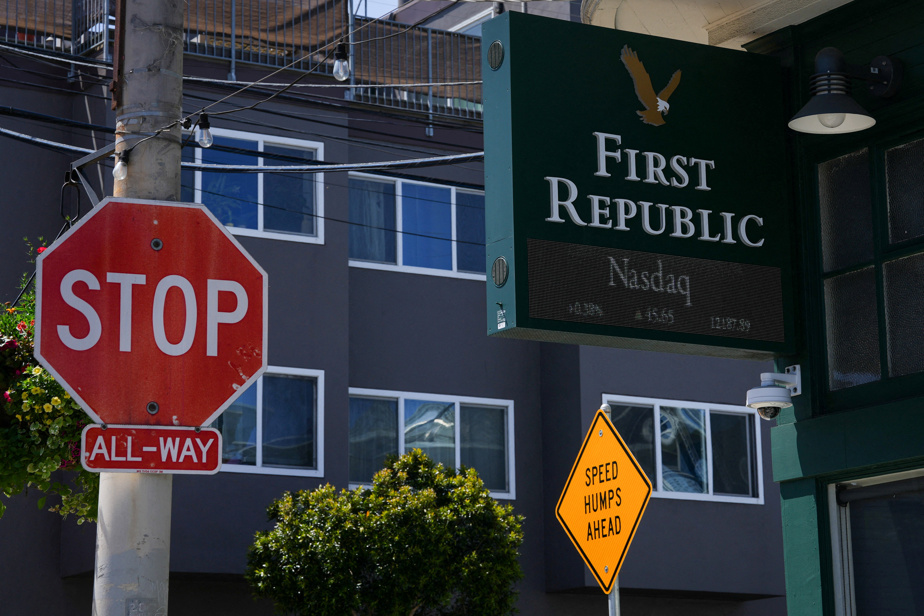(New York) The American authorities took control of the regional bank First Republic on Monday and sold the vast majority of it to JPMorgan Chase, thus recording the second largest bankruptcy in the history of the United States and hoping to put an end to the banking crisis that emerged in March.
The establishment was under great pressure since the close failures of two establishments with a similar profile, Silicon Valley Bank and Signature.
But First Republic failed to come up with a satisfactory rescue plan, and when it confirmed last Monday that scores of customers withdrew more than $100 billion in deposits in the first quarter, its already struggling stock took a hit. of the nose.
The authorities, who seemed reluctant to come to the rescue of a third bank in a short time, finally stepped up to the plate, soliciting offers from financial institutions before officially seizing First Republic.
It is the second largest bank failure in US history after that of Washington Mutual in 2008.
The assets of the latter had also been largely acquired by JPMorgan which, under the leadership of its boss Jamie Dimon, has several times rescued institutions in difficulty.
Under Monday’s deal, the country’s biggest bank will take back all of First Republic’s deposits and nearly all of its assets, while its branches can reopen on Monday as usual.
“Our government invited us and others to intervene, and we did,” Jamie Dimon said in a statement. According to him, the operation makes it possible to “ minimize the costs ” for the deposit insurance fund.
The deal does mean that First Republic’s loans are to be downgraded, and the agency responsible for guaranteeing the deposits, the FDIC, has agreed to cover some of those losses: it believes the deal will cost it about $13 billion, a sum that will come from contributions paid by the banks.
It also calls for JPMorgan to pay $10.6 billion to the FDIC.
The bidding process was “ very competitive ” and resulted in a transaction “ compliant with the requirements of least cost ”, assured the FDIC.
The Ministry of the Economy said it was “encouraged” by the solution found and, in a statement, assured that the American banking system remains “healthy and resilient”.
Jamie Dimon estimated for his part that the operation “will help stabilize the system”.
The authorities and other major banks intervened in March to prevent First Republic from meeting the same fate as SVB and Signature, with eleven financial institutions agreeing to deposit a total of $30 billion there, which will be reimbursed once the transaction is complete. finalized.
But that was not enough to reassure.
First Republic, founded in 1985 and based in San Francisco, was only worth $654 million on the stock market on Friday, compared to more than $20 billion at the start of the year.
She might seem attractive: she was known to have a wealthy clientele, depositing large sums into accounts and repaying loans well.
But many of them took fright after the bankruptcies of SVB and Signature. And it had a number of mortgages and fixed rate investments in its accounts, which mechanically lost value with the recent rise in interest rates.
Observers were worried about a risk of contagion after the failures of March, which also created turmoil across the Atlantic and accelerated the fall of Credit Suisse.
But these fears have eased somewhat after the publication in the past two weeks by several small and medium-sized banks of solid financial statements.
“ First Republic was identified as a problem bank in mid-March and the announcement of its closure does not constitute a new reason for concern ”, estimated Nicolas Veron, economist for the PIIE and Bruegel think tanks, before the formalization of bankruptcy.
JPMorgan’s stock climbed 5% in electronic trading on Wall Street. First Republic’s dropped 35%.
“We were not looking for this agreement, but it has financial advantages and allows us to strengthen ourselves in the market”, particularly in wealth management, JPMorgan’s chief financial officer, Jeremy Barnum, said on Monday.
The American bank First Republic was seized on Monday by the authorities, before being sold to JPMorgan. Its fall represents the second biggest bank failure in the United States, after the recent routs of Silicon Valley Bank and Signature Bank.
It is also the largest default by a bank since the 2007/08 financial crisis.
Here are the main precedents for retail banks, ranked by asset size.
These establishments were all retail banks, accessible to all individuals.
In addition, the financial crisis was marked by the bankruptcy of several finance and investment banks, primarily Lehman Brothers, which filed for bankruptcy on September 15, 2008.
It then had 639 billion US dollars in assets.
